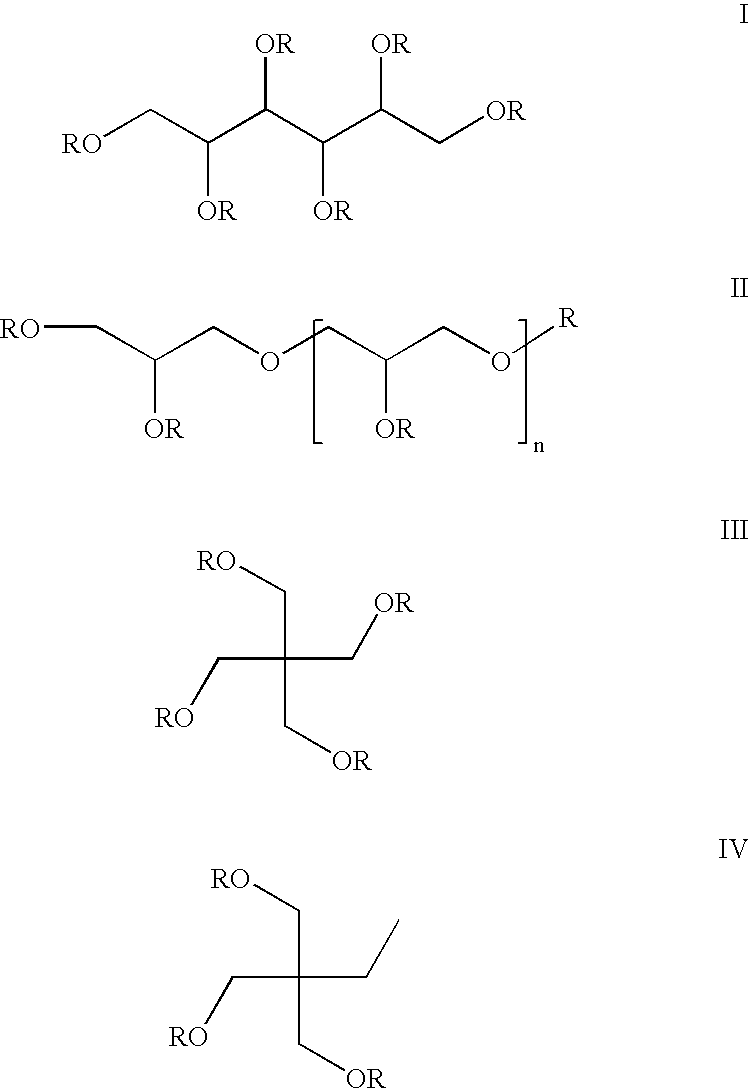Imaging members with ionic multifunctional epoxy compounds
- Summary
- Abstract
- Description
- Claims
- Application Information
AI Technical Summary
Benefits of technology
Problems solved by technology
Method used
Image
Examples
examples 1-7
Preparative Examples 1-7
Preparation of Epoxy Resin 1: Resin with Average Molecule Containing 5.3 Epoxy Units and 1.0 Trimethylalkylammonium Units.
10.0 g DENACOL® EX-521 epoxy resin (Nagase Chemicals) was combined with 75 ml methanol and 0.96 g trimethylamine hydrochloride in a 250 ml 2-neck round bottom flask fitted with a reflux condenser and a nitrogen inlet. The reaction was heated for 16 hours at 40° C. at which point analysis no trimethylamine could be detected by headspace gas chromatography. In addition, the 1H NMR spectrum showed complete disappearance of the trimethylamine protons and a proportional disappearance of a fraction of the oxirane protons at δ 2-5-2.8 ppm. In addition, proportional growth of a resonance at δ 2.75 ppm was assigned to the +N—CH3 protons. Some of the solvent was removed by rotary evaporation and the resin was stored as solution of 21.17% solids in methanol.
Preparation of Epoxy Resin 2: Resin with Average Molecule Containing 4.3 Epoxy Units and 2.0 T...
examples 1-4
Three coating formulations were prepared as detailed in Table 1:
TABLE 1Coating formulations in parts by weight.Exam-Exam-Exam-Example 4Ingredientple 1ple 2ple 3(comparative)poly(acrylic acid)0.6140.6140.6140.614Benzyltrimethylammonium3.5643.5643.5643.564hydroxide (40%)FX-GE-003*2.0402.0402.0402.040Epoxy Resin solution 11.980———Epoxy Resin solution 2—1.805——Epoxy Resin-solution 3——1.971—CR-5L**———0.408Lodyne 103A***0.0030.0030.0030.003n-propanol6.4186.5936.4277.990Water85.38185.38185.38185.381*FX-GE-003 is an ethanolic carbon dispersion obtained from Nippon Shokubai (Osaka, Japan). **CR-5L is a water-soluble multifunctional aliphatic non-ionic epoxide available from Esprix Technologies. ***Lodyne 103A is a fluorosurfactant available from Ciba Specialty Chemicals.
The formulations in Table 1 were coated onto grained, anodized aluminum and dried. The resulting printing plates were imaged on a Creo 3230 Trendsetter at 300, 400 and 500 mJ / cm2 (15W). The imaged plates were mounted directl...
examples 5-7
Three coating formulations were prepared as detailed in Table 2:
TABLE 2Coating formulations in parts by weight.Example 7IngredientExample 5Example 6(Comparative)poly(acrylic acid)0.6140.6140.614benzyltrimethylammonium3.5643.5643.564hydroxide (40%)FX-GE-0032.0402.0402.040Epoxy Resin solution 42.071——Epoxy Resin solution 5—2.071—CR-5L——0.204Lodyne 103A0.0030.0030.003n-propanol6.3276.3278.011water85.38185.38185.564
The formulations in Table 2 were coated onto grained, anodized aluminum and dried. The resulting printing plates were imaged on a Creo 3230 Trendsetter at 350 and 450 mJ / cm2 (15W). The imaged plates were mounted directly without processing on a Miehle printing press and 5,000 prints were made using Graphic Equinox Process Black Ink and a fountain solution formulated with Litho Etch 142W and PAR according to the manufacturer's (VARN) directions. After about 1,000 impressions the plate prepared according to comparative Example 7 began printing lightly in the background, and the...
PUM
| Property | Measurement | Unit |
|---|---|---|
| Mass | aaaaa | aaaaa |
| Substance count | aaaaa | aaaaa |
| Fraction | aaaaa | aaaaa |
Abstract
Description
Claims
Application Information
 Login to View More
Login to View More - R&D
- Intellectual Property
- Life Sciences
- Materials
- Tech Scout
- Unparalleled Data Quality
- Higher Quality Content
- 60% Fewer Hallucinations
Browse by: Latest US Patents, China's latest patents, Technical Efficacy Thesaurus, Application Domain, Technology Topic, Popular Technical Reports.
© 2025 PatSnap. All rights reserved.Legal|Privacy policy|Modern Slavery Act Transparency Statement|Sitemap|About US| Contact US: help@patsnap.com



